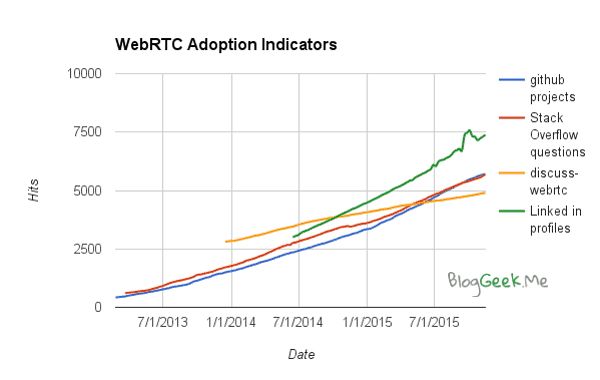A long, boring straight line.
In some ways, WebRTC now feels like a decade ago, when every time we said “next year will be the year of video”. For WebRTC? Next year will be the year of adoption.
Adoption is hard to define though. What does it really means when it comes to WebRTC?
- Browser vendors supporting it? (3 out of 4 with rumors about the fourth)
- The number of WebRTC-enabled devices? In the billions already
- Vendors using WebRTC? I am tracking now over 800 vendors and projects
WebRTC has been picked up by carriers (AT&T, Comcast and others if you care about name dropping), most (all?) video conferencing and unified communication vendors, education, banking and healthcare industries, contact centers.
While all is well in the world of WebRTC, there is no hype. A year and a half ago I wrote about it – the fact that there is no hype in WebRTC. It still holds true. Too true. And too steadily.
The chart below is a collection of 2 years of data of some of the data points I follow with WebRTC. I hand picked here 4 of them:
- The number of github projects mentioning WebRTC
- The number of questions/answers on Stack Overflow mentioning WebRTC
- The number of users subscribed to the discuss-webrtc Google group
- The number of LinkedIn profiles of people deciding to add WebRTC to their “resume”
In all of these cases (as well as other metrics I collect and follow), the trend is very stable. There’s growth, but that growth is linear in nature.
There are two minor areas worth mentioning:
- LinkedIn had a correction during September/October – a high increase and then an immediate decrease. Probably due to spam accounts that got caught by LinkedIn. I’ve seen this play out on Google+ account stats as well about a year ago
- github and StackOverflow had a slight change in their line angle from the beginning of 2015. This coincides with Google’s decision to host its samples and apprtc on github instead of on code.google.com – probably a wise decision, though not a game changer
Some believe that the addition of Microsoft Edge will change the picture. Statistics of Edge adoption and the statistics I’ve collected in the past two months show no such signs. If anything, I believe most still ignore Microsoft Edge.
Where does that put us?
Don’t be discouraged. This situation isn’t really bad. 2015 has been a great year for WebRTC. We’ve seen public announcements coming from larger vendors (call it adoption) as well as the addition of Microsoft into this game.
Will 2016 be any different? Will it be the breakout year? The year of WebRTC?
I doubt it. And not because WebRTC won’t happen. It already is. We just don’t talk that much about it.
If you are a developer, all this should be great news for you – there aren’t many others in this space yet, so demand versus supply of experienced WebRTC developers favors developers at the moment – go hone your skill. Make yourself more valuable to potential employers.
If you are a vendor, then find the most experienced team you can and hold on to them – they are your main advantage in the next years when it comes to outperforming your competitors when it comes to building a solid service.
We’re not in a hyped up industry as Internet of Things or Big Data – but we sure make great experiences.


When WebTorrrent (yes, a WebRTC browser and node.js javascript implementation of Bittorrent) came up on Hacker News frontpage this weekend someone mentioned: WebTorrent gets rediscovered every 3 months by the Internet.
I don’t know what that means about WebRTC, but it was an interesting observation.